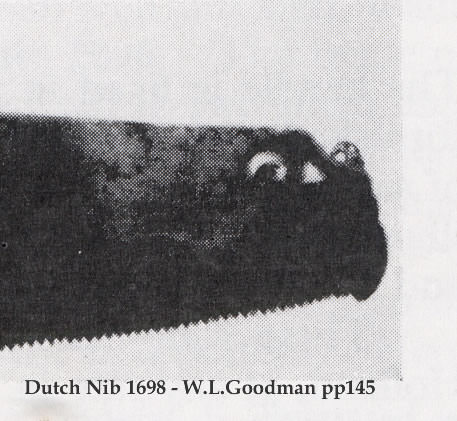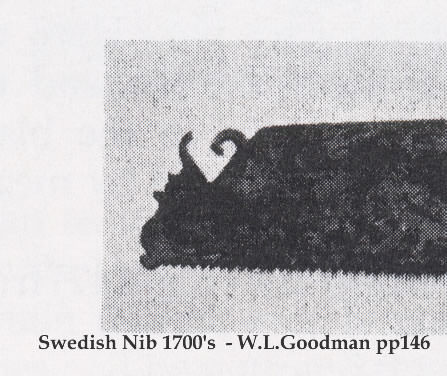Cheshirechappie
Established Member
Thank goodness we all now know.
:roll:
:roll:

I do get tired of that tone of sarcasm - especially coming from CC who regular misunderstands a great many things and has to have them explained patiently.Cheshirechappie":3aebakpk said:Thank goodness we all now know.
:roll:
I have no idea what they are for personally, I would guess they have been at one time all the things everyone is arguing about to different degrees.Jacob":23i10v3o said:Do you have an image of one of these decorative saws, I've never seen one?



Jacob":3o0n4o4b said:They were made for all and sundry. Every professional started as an amateur and every professional would have used an unfamiliar saw at some time or another.Corneel":3o0n4o4b said:The plate length indicator theory is not very plausible. These saws were made for professionals who knew how to use a saw without kinking.So in that case it was not a tell-tale......When you look at where the nib came from, Dutch 17 thcentury saws with the decorations on the very nose of the saw plate, you’ll see that is another clue that it wasn’t there as an indicator. Way too far forward.
We are talking about the nibs at 3 to 4" which are obviously there as tell-tales.
Do you have an image of one of these decorative saws, I've never seen one?Except generally they aren't decorative in the slightest, even on expensive saws with decorative curly handlesDecoration is a plausible explanation. ...
You are omitting the other circumstance in which a nib tell-tale would be handy - that is when anybody (beginner or pro) is using an unfamiliar saw. My modern hand saws are 22 and 26". My two saws with nibs are 24 and 28". Older saws are very variable. Having a nib is very handy which is exactly what I discovered first time I used them and being suddenly uncertain of the length.Corneel":44os2ljq said:.....Nobody would add a feature to a tool so it was "easy for a beginner". Kinking a sawblade was amateurish, and not even a beginning aprentice would have been allowed such stupid stuff.
Yes there is! some of them are very fancy - look at Bm101s images above. Incidentally both those saws have a tell-tale - the teeth end in an untoothed hook, which would be felt on the upstroke. Thats a good idea! Also in your example there are enough notches to function as a tell-tale, so they aren't decorative only, they are useful - a decorative tell-tale to match a decorative handle. Later the designs gets simplified and retain only the useful tell-tale function, but without decoration. Later again and even this is lost.... There isn't much opportunity for decoration on a high precision tool like a sawplate.
Bm101":396m7hba said:Jacob":396m7hba said:
No prob - as long as they are sharp and have roughly equal set both ways, it will cut. Teeth can go a long way out before they need topping - and even then it's sometimes not essential to top the whole edge - just the most irregular bits. This dramatically increases lifespan - excess topping is the fastest way to wear out a saw.Bale":1ojzpns7 said:Bm101":1ojzpns7 said:Jacob":1ojzpns7 said:
Hurrah! Someone else with my saw sharpening skills
Pete
Jacob":3swrhtzk said:No prob - as long as they are sharp and have roughly equal set both ways, it will cut. Teeth can go a long way out before they need topping - and even then it's sometimes not essential to top the whole edge - just the most irregular bits. This dramatically increases lifespan - excess topping is the fastest way to wear out a saw.
The hook at the end is the interesting bit - another tell-tale! It would be felt on the upstroke.
Corneel said:You should understand the work etique from those early times. Nobody would add a feature to a tool so it was "easy for a beginner". Kinking a sawblade was amateurish, and not even a beginning aprentice would have been allowed such stupid stuff. Toolmakers took woodworkers serious. No gentlemen woodworkers back then (we speak 17th/18th century here). When you want to understand antique tools you need to understand the social circumstances of that time too.
/quote]
Actually this is completely wrong in general, though no doubt true for the jobbing artisan. In the 17/18 C there was a great tradition of gentleman woodworkers amongst the aristocracy. See for example https://books.google.co.uk/books?id=d7d ... rs&f=false
This was especially true of woodturning. The treatises of Plumier 1792 and Holzapffel 1843-97 were written for the amateur or the scientist, both in practice members of the aristocracy who did not have to work for a living. The ornamental lathes designed by Holzapffel were primarily sold to the wealthy and nobility. See https://en.wikipedia.org/wiki/Ornamental_turning. Few professionals or their businesses could afford them.
So yes, there was indeed a tradition of ornamenting tools for such wealthy customers.
I still thinkJacob is right about the nib, though.
Keith
phil.p":344h5au7 said:That something's old as the hills doesn't necessarily show or prove it has or hasn't a purpose.
MusicMan":1p2gqt5z said:Corneel":1p2gqt5z said:You should understand the work etique from those early times. Nobody would add a feature to a tool so it was "easy for a beginner". Kinking a sawblade was amateurish, and not even a beginning aprentice would have been allowed such stupid stuff. Toolmakers took woodworkers serious. No gentlemen woodworkers back then (we speak 17th/18th century here). When you want to understand antique tools you need to understand the social circumstances of that time too.
/quote]
Actually this is completely wrong in general, though no doubt true for the jobbing artisan. In the 17/18 C there was a great tradition of gentleman woodworkers amongst the aristocracy. See for example https://books.google.co.uk/books?id=d7d ... rs&f=false
This was especially true of woodturning. The treatises of Plumier 1792 and Holzapffel 1843-97 were written for the amateur or the scientist, both in practice members of the aristocracy who did not have to work for a living. The ornamental lathes designed by Holzapffel were primarily sold to the wealthy and nobility. See https://en.wikipedia.org/wiki/Ornamental_turning. Few professionals or their businesses could afford them.
So yes, there was indeed a tradition of ornamenting tools for such wealthy customers.
I still thinkJacob is right about the nib, though.
Keith
just the nib; just retaining the minimum useful detail of tell-tale. Makes sense.Corneel":3ugdd4qn said:......
Likewise it could very well have happened with the saws. Dutch saws more ornate at the nose, the English with just that nib. ....
Go for it it's all harmless fun! You might find out something interesting but I wouldn't count on it. :roll:Lons":j0j2axoq said:I was going to post pics of the saws I have collected in need of restoration or dumping and ask the same advice as the OP of this thread but not sure I dare now. :roll:
None of mine have nibs though - I think.
Did you get a chance to review the previous thread?AJB Temple":37ya0fta said:You know, having read this lot, I reckon Jacob is right.
Enter your email address to join: